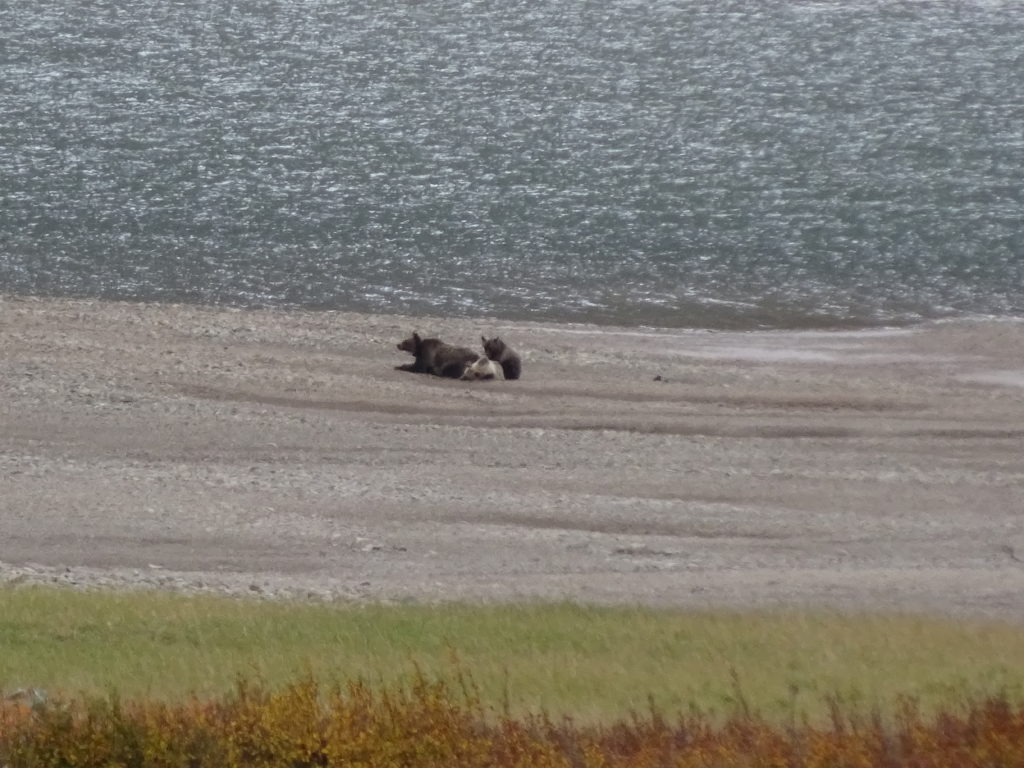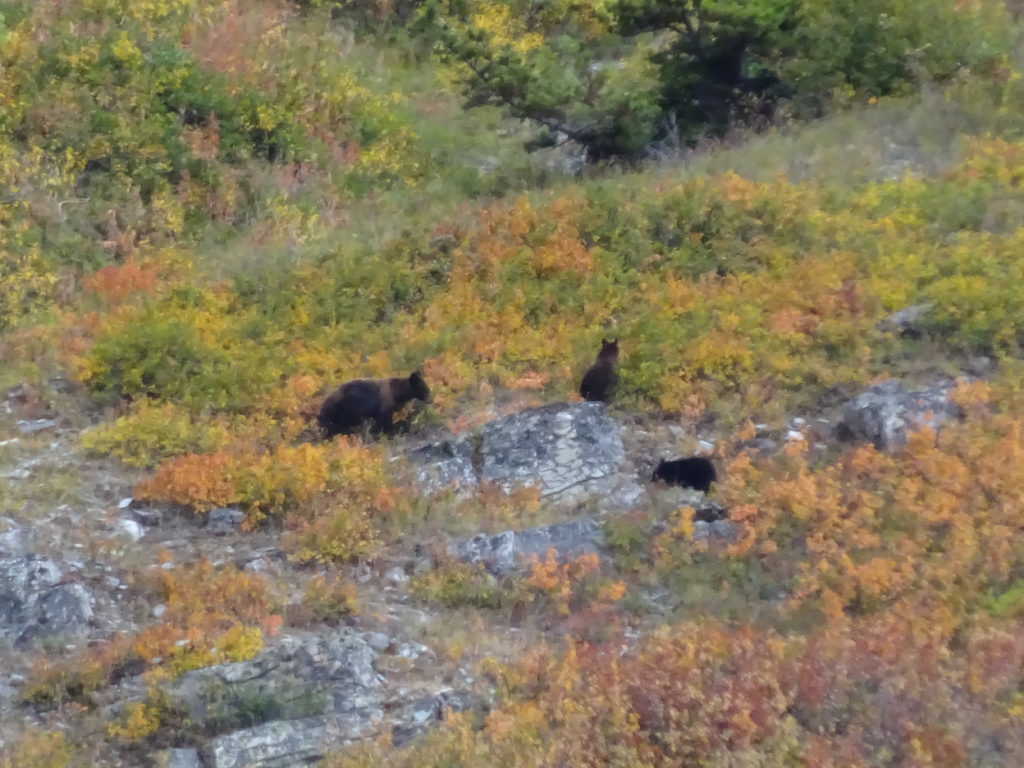I recently returned from a road trip beginning at Crater Lake, Oregon, traipsing up the coast, up the Columbia River Gorge, and finally to Glacier National Park in Montana. And thar be bears on the trip.
Glacier National Park has lost most of its glaciers. Of the more than 100 present when it was made a park in 1910, only 26 remain as “active glaciers.” Climate change is hastening the demise. There is, however, still wildlife in the park (though that too has diminished). In particular are bighorn sheep (Ovis canadensis) and black bears (Ursus americanus).

We saw the first bears – a mother and two cubs – snoozing on a sandy riverbank along the Many Glacier road. Because of the ongoing fires in the center of the park, we had to drive all the way around from the western side along the southern edge and up the eastern side of the park. It was here that we determined the inadequacy of our binoculars and camera equipment. Luckily we found a delightful gentleman who let us gaze up close and person through his powerful spotting scope. This trio of bears were a bit distant from the road so my photos aren’t perfect, but you can see the coloration of one of the two cubs is more silver than that of the mother black bear and the other cub. Black bears can be all black, have some silver or brown markings, or even all brown (not to be confused with brown bears, which are a different species and include the subspecies we know as “grizzly bears; I know, it’s complicated).
Earlier, on the Going to the Sun road in the center of the park we could make it as far as Logan Pass, after which the road was closed almost all the way to the western gate. Logan Pass is home to the highest point in the park and location of the Continental Divide marker at 6,646 feet. But our attention was grabbed by movement on the hillside – bighorn sheep. The most obvious characteristic is the namesake big horns on males. The horns themselves can weigh up to 30, a full tenth of their 300 pound total weight. The ones we saw were the Rocky Mountain bighorn, a subspecies commonly found in the area. Two other subspecies – the Sierra Nevada bighorn and Desert bighorn are found further south and are currently endangered.

Back on Many Glacier road we stopped outside the entrance to a park hotel. Up on the hill we saw another mother black bear with her two cubs. These again showed the light silvery touches to the shoulders and rump. They pretty much ignored us and other bear gawkers as they filled their bellies with grass and bushes. We think of bears as being carnivores, but most of their diet is vegetation. In September they are likely searching for hazelnuts, acorns, pine nuts, or berries such as huckleberries.
We didn’t see many other animals on the trip. No grizzly bears, no lynx, not even any mountain goats (the park’s symbol), moose, coyotes, or deer. We didn’t see any, but we clearly smelled skunk, another park regular. But we were satisfied to see the large group of bighorn sheep and two sets of bear trios. At least until the next time.
David J. Kent is an avid science traveler and the author of Lincoln: The Man Who Saved America, in Barnes and Noble stores now. His previous books include Tesla: The Wizard of Electricity (2013) and Edison: The Inventor of the Modern World (2016) and two e-books: Nikola Tesla: Renewable Energy Ahead of Its Time and Abraham Lincoln and Nikola Tesla: Connected by Fate.
Check out my Goodreads author page. While you’re at it, “Like” my Facebook author page for more updates!













Great photos!
Best I could get with my current photo limitations. 🙂
Too bad about the fires this year. The western side of Going to the Sun Road is really beautiful. At Logan Pass, you can cross the road from the station and take a trail that goes above the road on the other side of the pass all the way up to the fire lookout on Swiftcurrent Mountain. The trail is terrifying if you have a fear of heights, but it gives an awesome view over the western side of the pass. Long hike up the mountain, but it has a 360° view of the park. How heavy was the tourist traffic at the time you went through?
Cool pictures… Most of the bears I see around here live in town. I’m not kidding. The bear crossing signs along the roads are oriented for people coming into town. I have a photo on my FB page of a mamma and a couple of cubs I had to wait for while they leisurely crossed a road in town. Usually pretty mellow… still, I run with a can of bear spray.
No mountain sheep. But I discovered we have (very large) elk last year… after nearly hitting one with my truck.
From the west side we could only go in less a mile or two, just to the tip of Lake McDonald. From there we could see the fires on the ridge opposite us, complete with a dual-rotor helicopter dropping water from the lake. Maybe some day I’ll get back.
I was hoping to see some elk, but it was not to be. I’m thinking of doing Yellowstone in the spring.
The view from the west end of Lake McDonald is very beautiful… though it doesn’t usually include smoke and helicopters. Some local clips my husband took a couple of years back (ignore the title): https://www.youtube.com/watch?v=Kjp52Acu9Ow
Mountain wildlife tends to be a little more difficult to plan to see. I suspect Yellowstone will have more easily spotted fauna-of-interest. I’ve never seen a Grizzly in the wild.
It was also rainy, so I’m sure it wasn’t putting on its best show. The helicopter we saw was similar to that one but not so close. Great video!
One of the trails we took to get to a waterfall had signs warming to watch for grizzlies. I was kinda glad we didn’t see any then. I’m looking forward to Yellowstone as I’ve never been there.